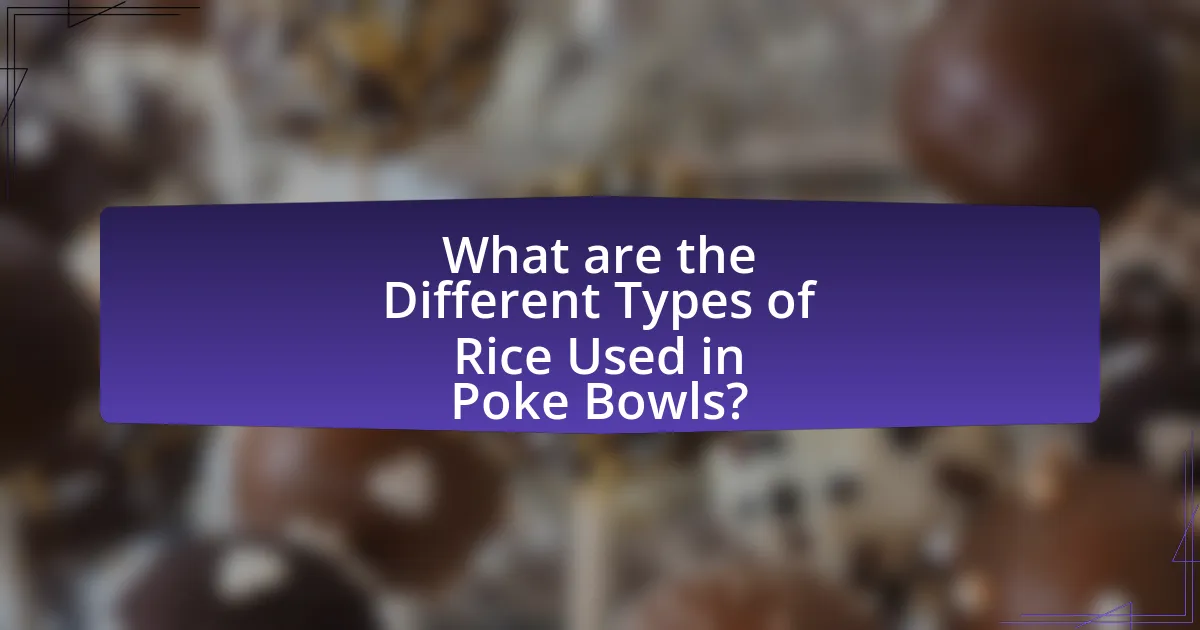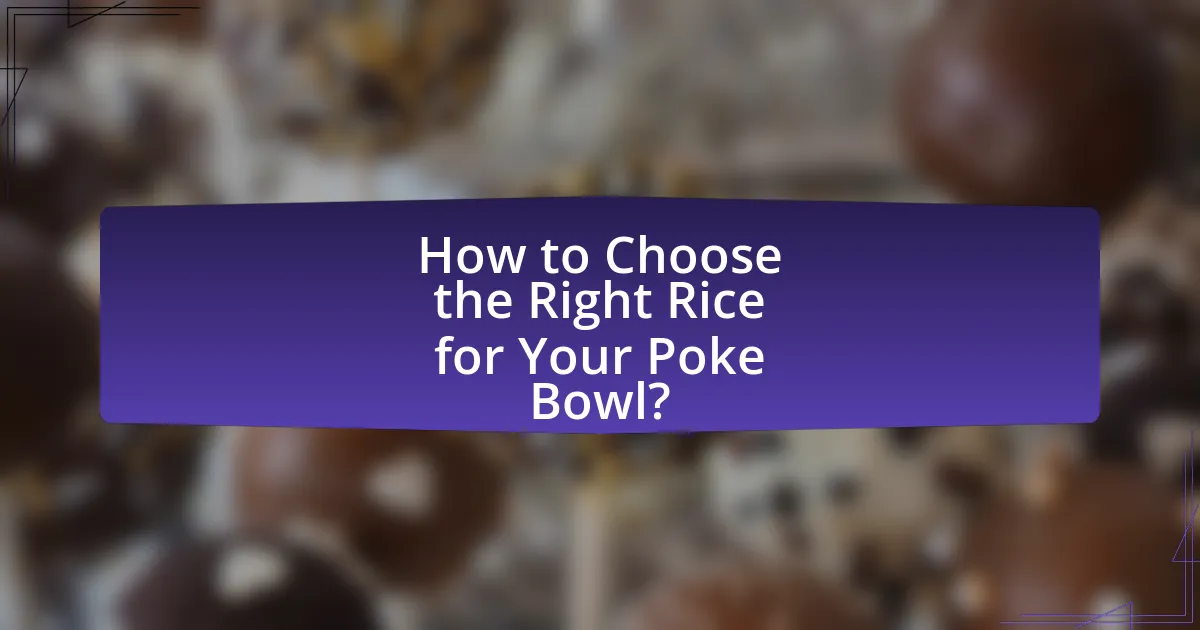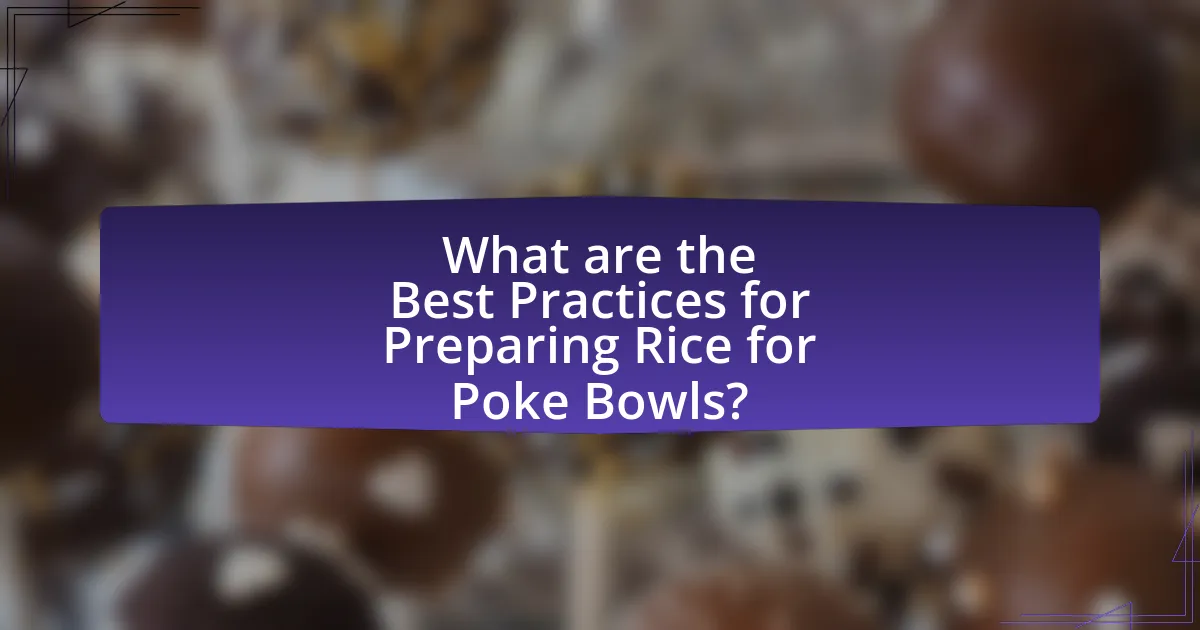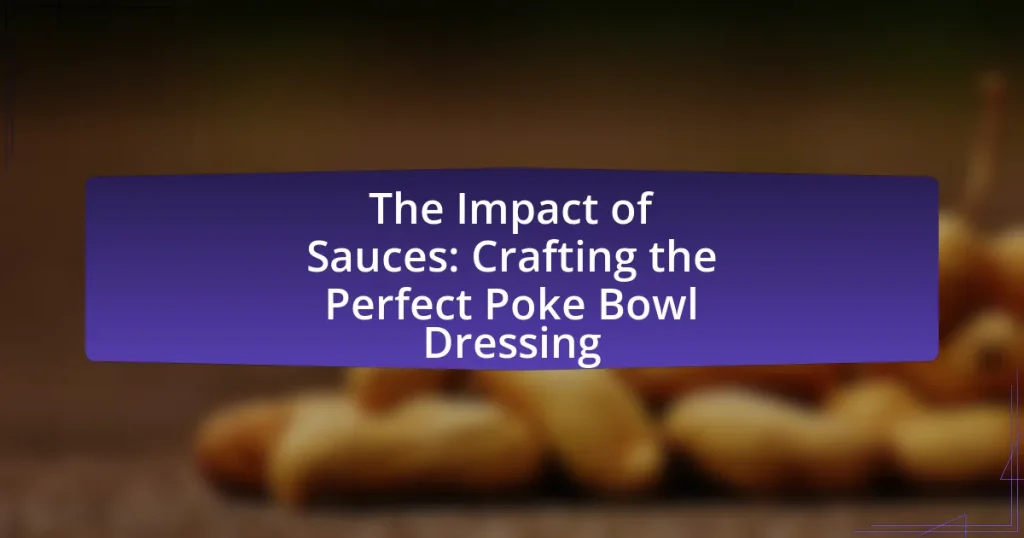The article focuses on understanding the different types of rice used in poke bowls, highlighting sushi rice, brown rice, and cauliflower rice. It examines how each rice variety impacts the overall poke bowl experience through texture, flavor, and nutritional value. The article also discusses the flavor profiles of different rice types, the importance of texture in enhancing enjoyment, and best practices for preparing rice to achieve the ideal consistency. Additionally, it provides insights into cooking methods, seasoning options, and common mistakes to avoid when preparing rice for poke bowls.

What are the Different Types of Rice Used in Poke Bowls?
The different types of rice used in poke bowls include sushi rice, brown rice, and cauliflower rice. Sushi rice, a short-grain rice, is commonly used due to its sticky texture, which helps the ingredients adhere together. Brown rice, a whole grain option, offers a nuttier flavor and more fiber compared to white rice. Cauliflower rice serves as a low-carb alternative, appealing to those seeking a lighter option. Each type of rice contributes unique textures and flavors, enhancing the overall poke bowl experience.
How do the varieties of rice impact the overall poke bowl experience?
The varieties of rice significantly impact the overall poke bowl experience by influencing texture, flavor, and nutritional value. For instance, sushi rice, which is commonly used, has a sticky texture that helps the ingredients adhere together, enhancing the overall mouthfeel. In contrast, brown rice offers a nuttier flavor and higher fiber content, appealing to health-conscious consumers. Additionally, jasmine rice provides a fragrant aroma and a slightly fluffy texture, which can elevate the sensory experience of the dish. Each rice type contributes uniquely to the poke bowl, affecting not only taste but also the visual appeal and satisfaction of the meal.
What are the flavor profiles of different rice types?
Different rice types exhibit distinct flavor profiles that influence their use in dishes like poke bowls. For instance, sushi rice has a slightly sweet and tangy flavor due to the addition of rice vinegar, making it ideal for sushi and poke. Jasmine rice offers a floral aroma and a subtle nutty taste, which complements fresh ingredients in poke bowls. Basmati rice, known for its long grains, has a fragrant and nutty flavor, often used in various Asian cuisines. Brown rice provides a more earthy and robust flavor, along with a chewy texture, appealing to health-conscious consumers. Each rice type’s unique flavor enhances the overall taste experience in poke bowls, making the choice of rice crucial for achieving the desired culinary effect.
How does the texture of rice affect poke bowl enjoyment?
The texture of rice significantly affects poke bowl enjoyment by influencing the overall mouthfeel and balance of flavors. For instance, sushi rice, which is sticky and slightly chewy, enhances the experience by allowing the rice to clump together, making it easier to pick up with chopsticks and providing a satisfying bite. In contrast, long-grain rice varieties, which are drier and less sticky, may lead to a less cohesive dish, potentially diminishing the enjoyment as the flavors from the toppings may not meld as effectively. Studies indicate that texture plays a crucial role in food perception, with consumers often preferring textures that complement the other ingredients in a dish, thereby reinforcing the importance of rice texture in enhancing the overall poke bowl experience.
What are the most popular rice types for poke bowls?
The most popular rice types for poke bowls are sushi rice, brown rice, and cauliflower rice. Sushi rice, a short-grain rice seasoned with vinegar, sugar, and salt, is favored for its sticky texture that holds ingredients together. Brown rice, a whole grain option, offers a nuttier flavor and higher nutritional value, appealing to health-conscious diners. Cauliflower rice, a low-carb alternative made from grated cauliflower, caters to those seeking a lighter, vegetable-based option. These rice types are commonly chosen for their unique textures and flavors that complement the fresh ingredients typically found in poke bowls.
What is sushi rice and why is it commonly used?
Sushi rice is a short-grain rice variety, specifically Japonica, that is seasoned with a mixture of vinegar, sugar, and salt after cooking. This seasoning process gives sushi rice its distinctive flavor and sticky texture, which is essential for holding the rice together in sushi rolls and other dishes. Sushi rice is commonly used because its sticky consistency allows it to easily form shapes and adhere to other ingredients, making it ideal for sushi preparation and enhancing the overall dining experience.
How does brown rice differ from white rice in poke bowls?
Brown rice differs from white rice in poke bowls primarily in its nutritional profile and texture. Brown rice retains its bran and germ layers, making it higher in fiber, vitamins, and minerals compared to white rice, which has been milled to remove these components. This higher fiber content in brown rice can aid digestion and promote satiety, while the chewy texture of brown rice contrasts with the softer, more delicate texture of white rice, providing a different mouthfeel in poke bowls.
What role does jasmine rice play in poke bowl recipes?
Jasmine rice serves as a flavorful and aromatic base in poke bowl recipes. Its slightly sticky texture and nutty fragrance complement the fresh ingredients typically found in poke bowls, such as raw fish, vegetables, and sauces. Jasmine rice is often preferred for its ability to absorb flavors, enhancing the overall taste profile of the dish. Additionally, its long-grain structure provides a pleasant mouthfeel, making it a popular choice among chefs and home cooks alike.

How to Choose the Right Rice for Your Poke Bowl?
To choose the right rice for your poke bowl, opt for short-grain sushi rice, as it has the ideal sticky texture that holds together well. This type of rice absorbs flavors effectively and provides a satisfying bite, making it a popular choice for poke bowls. Sushi rice is typically seasoned with rice vinegar, sugar, and salt, enhancing its taste and complementing the fresh ingredients commonly used in poke bowls.
What factors should you consider when selecting rice for poke bowls?
When selecting rice for poke bowls, consider the rice type, texture, and flavor profile. Short-grain rice, such as sushi rice, is preferred due to its sticky texture, which helps the rice hold together and complement the poke ingredients. The flavor should be mild and slightly sweet, enhancing the overall dish without overpowering it. Additionally, the cooking method is crucial; properly cooked rice should be fluffy yet cohesive, ensuring a pleasant eating experience. These factors collectively contribute to the authenticity and enjoyment of poke bowls.
How does the nutritional value of rice influence your choice?
The nutritional value of rice significantly influences my choice by determining its health benefits and suitability for specific dietary needs. For instance, brown rice offers higher fiber content and essential nutrients compared to white rice, making it a preferred option for those seeking to improve digestion and maintain stable blood sugar levels. Additionally, the protein content in rice varieties can affect choices for individuals focusing on muscle building or weight management, as certain types provide more protein per serving. Studies indicate that whole grain rice varieties, such as brown or black rice, contain antioxidants and vitamins that contribute to overall health, further guiding the selection process for a balanced diet.
What cooking methods are best for different rice types?
The best cooking methods for different rice types vary based on their characteristics. For short-grain rice, such as sushi rice, the optimal method is steaming or using a rice cooker, which ensures a sticky texture ideal for sushi and poke bowls. Medium-grain rice, like Calrose, also benefits from steaming or boiling, producing a slightly firmer texture that holds up well in dishes. Long-grain rice, such as basmati or jasmine, is best cooked using the absorption method, where water is fully absorbed, resulting in fluffy grains that separate easily. Each method aligns with the rice type’s inherent qualities, ensuring the desired texture and flavor for poke bowls.
How can you enhance the flavor of rice in poke bowls?
To enhance the flavor of rice in poke bowls, incorporate seasonings such as rice vinegar, sesame oil, and salt during the cooking process. Rice vinegar adds acidity and brightness, while sesame oil contributes a nutty flavor, both of which complement the overall dish. Additionally, using a broth instead of water for cooking the rice can infuse it with deeper flavors, making it more savory. This method is supported by culinary practices that emphasize the importance of flavor layering in dishes, particularly in Asian cuisine, where rice is often seasoned to elevate its taste.
What seasonings can be added to rice for better taste?
Seasonings that can be added to rice for better taste include salt, pepper, garlic powder, onion powder, soy sauce, and sesame oil. These seasonings enhance the flavor profile of rice, making it more appealing in dishes like poke bowls. For instance, soy sauce adds umami, while sesame oil contributes a nutty aroma, both of which complement the fresh ingredients typically found in poke bowls.
How does marinating rice affect its flavor profile?
Marinating rice enhances its flavor profile by allowing the grains to absorb the marinade’s ingredients, resulting in a more complex taste. The process of marination introduces various flavors, such as acidity from vinegar or citrus, sweetness from sugar, and umami from soy sauce, which penetrate the rice and alter its inherent flavor. Studies show that marinated rice can exhibit a more balanced and layered taste, making it more appealing in dishes like poke bowls, where flavor depth is essential.

What are the Best Practices for Preparing Rice for Poke Bowls?
The best practices for preparing rice for poke bowls include using short-grain sushi rice, rinsing the rice thoroughly, cooking it with the right water-to-rice ratio, and seasoning it with rice vinegar, sugar, and salt after cooking. Short-grain sushi rice is preferred due to its sticky texture, which helps the rice hold together in the bowl. Rinsing the rice removes excess starch, preventing it from becoming gummy during cooking. A typical water-to-rice ratio for sushi rice is 1:1.2, ensuring the rice is cooked properly. After cooking, seasoning the rice with a mixture of rice vinegar, sugar, and salt enhances its flavor and complements the poke bowl’s ingredients. These practices are essential for achieving the ideal texture and taste in poke bowl rice.
How do you properly cook sushi rice for poke bowls?
To properly cook sushi rice for poke bowls, rinse the rice under cold water until the water runs clear to remove excess starch, then soak it for 30 minutes. After soaking, drain the rice and combine it with water in a pot using a 1:1.2 rice-to-water ratio. Bring the mixture to a boil, then reduce the heat to low, cover, and simmer for 18-20 minutes. Once cooked, let the rice sit covered for an additional 10 minutes, then fluff it with a rice paddle. This method ensures the rice achieves the desired sticky texture essential for poke bowls.
What are the steps to achieve the perfect sticky rice texture?
To achieve the perfect sticky rice texture, first, select glutinous rice, which is specifically cultivated for its sticky properties. Next, rinse the rice thoroughly under cold water until the water runs clear to remove excess starch, which can affect texture. After rinsing, soak the rice in water for at least 4 hours or overnight to allow it to absorb moisture, ensuring it cooks evenly. Then, drain the soaked rice and steam it in a bamboo or metal steamer lined with cheesecloth for about 30 to 40 minutes, ensuring it is cooked through but not mushy. Finally, let the rice rest for 10 minutes after steaming to allow the moisture to redistribute, resulting in the desired sticky texture. These steps are essential because glutinous rice contains a higher amylopectin content, which contributes to its stickiness when cooked properly.
How can you prevent rice from becoming mushy?
To prevent rice from becoming mushy, rinse the rice thoroughly before cooking to remove excess starch. This step is crucial because excess starch can lead to a sticky texture, resulting in mushy rice. Additionally, using the correct water-to-rice ratio is essential; typically, a 1:1.5 ratio of rice to water works well for most types of rice. Cooking the rice at a simmer rather than a rolling boil also helps maintain its structure. Finally, allowing the rice to rest covered after cooking for about 10 minutes allows it to firm up, further preventing mushiness.
What tips can help you serve rice in poke bowls effectively?
To serve rice in poke bowls effectively, use short-grain sushi rice, as its sticky texture helps it hold together and complement the other ingredients. Rinse the rice thoroughly before cooking to remove excess starch, which prevents it from becoming gummy. Cook the rice with a 1:1.2 ratio of rice to water for optimal texture, and allow it to rest covered for 10 minutes after cooking to enhance fluffiness. Season the rice with a mixture of rice vinegar, sugar, and salt while it is still warm to add flavor and balance the dish. These techniques ensure that the rice enhances the overall poke bowl experience by providing a solid base that pairs well with fresh toppings.
How should rice be stored before serving in poke bowls?
Rice should be stored in a covered container at room temperature before serving in poke bowls. This method prevents the rice from drying out and maintains its texture, which is essential for the overall quality of the poke bowl. Additionally, keeping the rice covered helps to retain moisture and flavor, ensuring that it remains palatable when served. Proper storage is crucial, as rice that is improperly stored can become hard or lose its appealing consistency, negatively impacting the dish.
What are the common mistakes to avoid when preparing rice for poke bowls?
Common mistakes to avoid when preparing rice for poke bowls include not rinsing the rice, using the wrong rice type, and improper cooking methods. Rinsing the rice removes excess starch, which prevents the rice from becoming gummy; failing to do so can lead to an undesirable texture. Using short-grain sushi rice is essential, as it provides the right stickiness for poke bowls; using long-grain rice can result in a less cohesive dish. Additionally, cooking rice with too much water can make it mushy, while too little water can leave it undercooked. Proper water-to-rice ratios and cooking techniques are crucial for achieving the ideal consistency.



